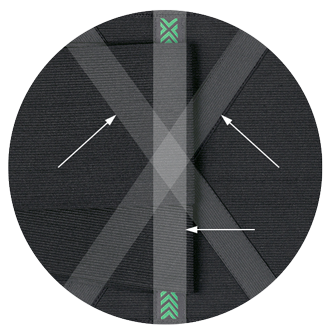Why It Works
Contrary to popular belief, chronic back, neck, hip and leg pain does not always originate in the back. In fact, a large majority of these issues – along with most muscle strain – can be directly traced to two natural biomechanical phenomena: gravity and balance. So let’s talk gravity: The pelvis is the central link in a kinetic chain that connects the upper and lower body, which makes it our very own center of gravity. And because this lumbar-pelvic-hip complex links the body’s two primary weight-bearing joints, this core zone is essential to posture alignment and overall stability. If your center of gravity is out of balance, the function of your arms, legs, gait and athletic ability will undoubtedly be compromised.

Now consider balance: As we age, we all develop what can be considered a ‘functional scoliosis’. In other words, we tend to favor one side of our body until we eventually create unevenness in our posture. Most of us are right side dominant; we learn to eat, write, throw, bat, drive, swing a golf club, and do all activities of daily living engaging our right side. Naturally, this causes a pelvic imbalance. And when the pelvic area is out of balance, the abnormal stress it places on one side of the body affects your strength and movement.
Clearly, the key to relief of compromised posture and chronic pain is our lumbar-pelvic-hip alignment. So why had no back support belt ever been invented to address this? New York-based Chiropractic Orthopedist Dr. Ron Safko was asked the same question.
And in 2014, he decided to do something about it.
Dr. Safko – a decorated Marine who served in Vietnam – had built a successful Manhattan practice with clients that ranged from CEOs to professional athletes. But it was his active boomer and senior patients – particularly golfers – who were all suffering from similar hip and back issues. As we get older, wear and tear on the pelvic bones and joints can cause significant and painful problems which demand increased pelvic and lower back support. In our lower backs, there is a three-sided angle formed by 1) the L4-L5 spinal segments 2) the sacrum and sacroiliac joints and 3) the pelvic iliac crest. This lumbar-sacral triangle – when distressed by disc issues and vertebrae slippage due to pelvic imbalance – becomes ground zero for the majority of muscle spasms, sciatic or stenosis issues as well as most chronic lower back and hip problems. You could just call it ‘The Triangle of Pain’.
 This became Dr. Safko’s starting point. He began to analyze dozens of back supports and braces designed for the pelvic region, including low back belts sacroiliac belts, lumbosacral belts, and trochanteric belts, only to find that none of them did what he wanted them to do. Using his expert knowledge of pelvic instability as a foundation, colleagues in manufacturing as expediters and his client base as his laboratory, he began to design and produce several different back support belt prototypes for his patients to wear while golfing or simply doing day-to-day activities. After four years of research, development and clinical trials, Dr. Safko finally arrived at a self-bracing mechanism for the pelvic musculature that he called his ‘X Factor®’:
This became Dr. Safko’s starting point. He began to analyze dozens of back supports and braces designed for the pelvic region, including low back belts sacroiliac belts, lumbosacral belts, and trochanteric belts, only to find that none of them did what he wanted them to do. Using his expert knowledge of pelvic instability as a foundation, colleagues in manufacturing as expediters and his client base as his laboratory, he began to design and produce several different back support belt prototypes for his patients to wear while golfing or simply doing day-to-day activities. After four years of research, development and clinical trials, Dr. Safko finally arrived at a self-bracing mechanism for the pelvic musculature that he called his ‘X Factor®’:

First, the belt is designed with a wider sacral-area control center with tapered ends for securing the belt around the users pelvic-iliac crest. By utilizing small flexible steel ‘X’ stays, bisected with a vertical longitudinal stay in the sacrum and sacroiliac joint area, he was able to stabilize the lower lumbar spine segments without weakening the core muscles. In addition to these core stabilizers, strategically placed soft stretchable compression X’s protected against excessive pelvic twisting, tilting or over-extension associated with golf or other sports and activities. This also decreased muscle recoil specifically associated with the golf swing while simultaneously aiding in muscle recovery. The specific orthopedic arrangement of these X’s resulted in what Dr. Safko called ‘Enhanced Momentum Control’.
 With this unique focus on lumbar-pelvic-hip alignment, Dr. Safko’s design is unlike any other support on the market. And because of its simultaneous vertical longitudinal support and torsional support of
With this unique focus on lumbar-pelvic-hip alignment, Dr. Safko’s design is unlike any other support on the market. And because of its simultaneous vertical longitudinal support and torsional support of
both the spine and pelvis, the belt also encourages the body to attain proper posture. Using lightweight elastic fabric and double-secured Velcro®, Dr. Safko had created a safe and comfortable closure mechanism that intuitively adjusted the body’s natural core alignment while relieving back, hip and leg issues. The effects were both immediate and far-reaching.
Dr. Safko’s new pelvic belt not only engaged core muscles, improved posture and reduced low back, pelvic and hip pain – especially back pain from golf swings – it does so with minimal probability of further injury. Its breathable fabric ensures a safe, comfortable and fully flexible fit. Dr. Safko soon found that his now-patented X-Factor Belt® worked for patients of every age – some with neuromuscular diseases, chronic arthritic hip pain and an array of muscular skeletal issues – allowing them to cut back on pain medications, move through any discomfort and fully re-commit to an active lifestyle with unrestricted range of motion.
And because it’s Protective. Corrective. Proven Effective., the X-Factor Belt® is like no other belt on the market.
